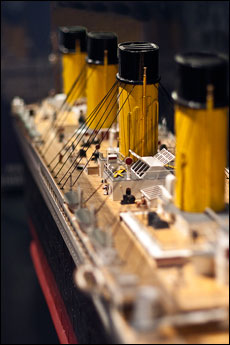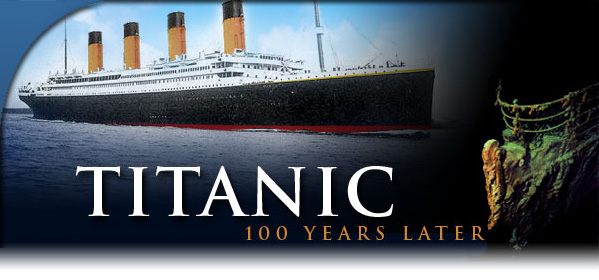Error processing SSI file
Titanic as Part of America's Maritime Cultural Landscape
In the landscape of American history and culture, the sinking of RMS Titanic remains one of the more powerful events of the early 20th century. The loss of Titanic had a profound impact on many families, among them some of America's more prominent citizens. The sinking of the ship also doomed a number of people who were steaming in Titanic across the Atlantic, heading to the United States with the intention of becoming Americans. One of the victims of the sinking, Franz Pulbaum, a 27 year old second class passenger from Germany, completed a declaration of intent to become a U.S. citizen on February 17, 1912. He joined Titanic on April 10, 1912 at Cherbourg, France. Five days later, he died when the ship sank. His luggage, discovered and raised from the wreck site by RMS Titanic, Inc. in 1993, was treated in their laboratories. Among the artifacts preserved inside Mr. Pulbaum's steamer trunk was his declaration of intent. That single paper artifact is one of many poignant and striking reminders of Titanic's relevance to Americans.

Titanic beginning a day of sea trials, April 12, 1912. |
Another is the story of Swedish immigrant Alma Cornelia Pålsson , who was on board with her four children to join her husband Nils, who had immigrated to America in 1910 to find a job along with Alma's two brothers. With money raised after two years' hard work, Nils sent tickets to Alma and the children to join him in Chicago. They sailed on Titanic and all of them died. Their loss, like that of Franz Pulbaum and so many others, was a loss for America as well as a deeply felt family tragedy. , who was on board with her four children to join her husband Nils, who had immigrated to America in 1910 to find a job along with Alma's two brothers. With money raised after two years' hard work, Nils sent tickets to Alma and the children to join him in Chicago. They sailed on Titanic and all of them died. Their loss, like that of Franz Pulbaum and so many others, was a loss for America as well as a deeply felt family tragedy.
The statistics of the disaster note that out of some 1,315 passengers on Titanic, 306 were U.S. citizens; 119 survived while 177 did not . The loss of the American passengers was the greatest number of the dead other than those from Britain, with 223 lost out of 327 British passengers. Among the lost Americans were millionaire John Jacob Astor, Maj. Archibald Butt, military aide to President William Taft, Denver socialite and women's rights activist Margaret (the "unsinkable Molly") Brown, Macy's Department Store owners Isador and Ida Strauss and his wife Ida, Lulu Drew and her son Marshall, from Greenpoint, New York, William Harbeck from Toledo, Ohio, Mrs. Clare Karnes from Pittsburgh, Pennsylvania, Mrs. Lutie Davis Parrish from Woodford County, Kentucky, Johan Andersson from Hartford, Connecticut, and Claus and Jennie Hansen from Racine, Wisconsin. If a map of all the Americans who sailed on Titanic were plotted, while a number came from New York or nearby, other pins on that map would reach across the country, as these few names attest. . The loss of the American passengers was the greatest number of the dead other than those from Britain, with 223 lost out of 327 British passengers. Among the lost Americans were millionaire John Jacob Astor, Maj. Archibald Butt, military aide to President William Taft, Denver socialite and women's rights activist Margaret (the "unsinkable Molly") Brown, Macy's Department Store owners Isador and Ida Strauss and his wife Ida, Lulu Drew and her son Marshall, from Greenpoint, New York, William Harbeck from Toledo, Ohio, Mrs. Clare Karnes from Pittsburgh, Pennsylvania, Mrs. Lutie Davis Parrish from Woodford County, Kentucky, Johan Andersson from Hartford, Connecticut, and Claus and Jennie Hansen from Racine, Wisconsin. If a map of all the Americans who sailed on Titanic were plotted, while a number came from New York or nearby, other pins on that map would reach across the country, as these few names attest.
A number of other places - buildings, memorials and graves in the United States are also part of the unique American maritime cultural landscape related to the loss of Titanic. They include:
- Pier 54, on New York's Hudson River shore at West 12th Street in the Meatpacking/Greenwich Village district, where the Cunard liner Carpathia landed with Titanic's survivors;
- The Titanic Memorial Lighthouse
 at Water Street and Fulton in New York; at Water Street and Fulton in New York;
- A memorial to Isador and Ida Straus
 at 106th and Broadway in New York. Mr. Straus' body was recovered and interred at Woodlawn Cemetery at 106th and Broadway in New York. Mr. Straus' body was recovered and interred at Woodlawn Cemetery in Brooklyn, while Mrs. Straus' was never found; in Brooklyn, while Mrs. Straus' was never found;
- A memorial to journalist W. T. Stead
 , who died on Titanic, at 91st and Central Park East in New York; , who died on Titanic, at 91st and Central Park East in New York;
- The Titanic Memorial
 (also known as the Women's Titanic Memorial) at Fourth and P streets, SW in Washington, D.C.; (also known as the Women's Titanic Memorial) at Fourth and P streets, SW in Washington, D.C.;
- The Ohio Titanic Memorial
 at the Great Lakes Science Center in Cleveland; at the Great Lakes Science Center in Cleveland;
- The Ohio gravesites of Titanic victims
 ; ;
 - The graves of the Asplund family
 , who were traveling third class on Titanic, are in the Old Swedish Cemetery in Worcester, Massachusetts. Four of the family, the father and three sons, died, but their mother, sister and a younger brother, survived. Lillian Gertrud Asplund, then a five year, was the last living American survivor of the disaster. She died in May 2006 and is interred with her family; , who were traveling third class on Titanic, are in the Old Swedish Cemetery in Worcester, Massachusetts. Four of the family, the father and three sons, died, but their mother, sister and a younger brother, survived. Lillian Gertrud Asplund, then a five year, was the last living American survivor of the disaster. She died in May 2006 and is interred with her family;
- A cenotaph memorial to Maj. Archibald Butt
 at Arlington National Cemetery; at Arlington National Cemetery;
- A memorial fountain to Maj. Butt
 on the Ellipse opposite the South Lawn of the White House; on the Ellipse opposite the South Lawn of the White House;
- The Henry Elkins Widener Memorial Library
 at Harvard University commemorates the loss of this young man in the sinking of Titanic; at Harvard University commemorates the loss of this young man in the sinking of Titanic;
- The grave of John Jacob Astor
 at the Trinity Church Cemetery and Mausoleum at 155th and Broadway in Manhattan; at the Trinity Church Cemetery and Mausoleum at 155th and Broadway in Manhattan;
- The Titanic Historical Society with its museum of artifacts donated by Titanic survivors, at 208 Main Street in Indian Orchard, Massachusetts. Founded in 1963, they were the first organization dedicated to preserving the legacy of the ship and those on board;
- The half-scale Titanic replica and museum
 in Branson, Missouri; in Branson, Missouri;
- The home, now a museum, of Titanic survivor Margaret (the "unsinkable Molly") Brown
 at 1340 Pennsylvania Street in Denver, Colorado; at 1340 Pennsylvania Street in Denver, Colorado;
- The Mariners' Museum
 , in Newport News, Virginia, has a permanent exhibition in the Great Hall of Steam gallery featuring Titanic and artifacts recovered from the sea in 1912 or donated by survivors. , in Newport News, Virginia, has a permanent exhibition in the Great Hall of Steam gallery featuring Titanic and artifacts recovered from the sea in 1912 or donated by survivors.
|



